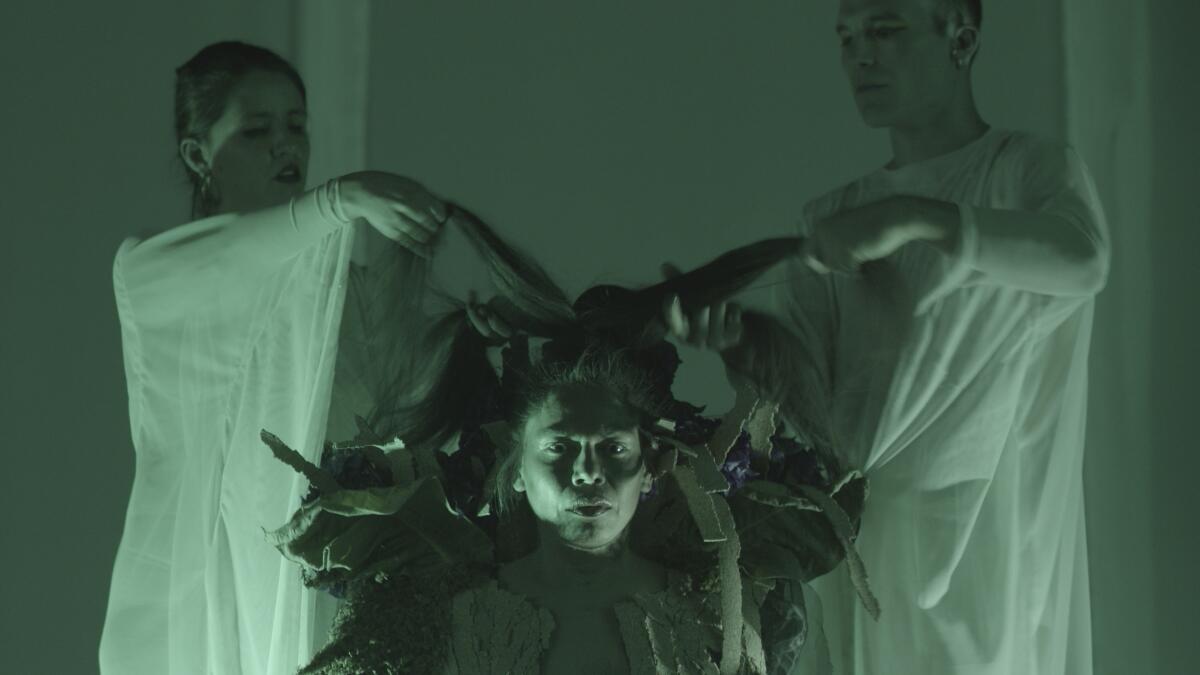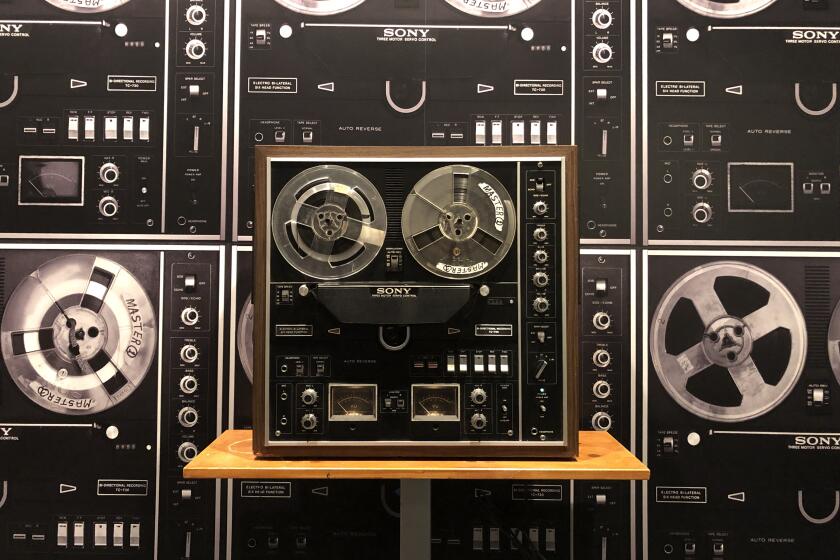An immersive show challenging the gender binary combines dirt and a futuristic soundscape

- Share via
The story of “BIGUIDIRIBELA” began with dirt, projections and the sound of breathing through leaves. Commissioned by LACMA and created by the MUXX Project — a collective consisting of Lukas Avendaño, EYIBRA (Abraham Brody), NNUX (Ana Lopez) and Oswaldo Erréve — used performance and 3-D technologies to explore gender expressions connecting to the Muxe identity of the Didxazaa (Zapotec) people.
The show unfolded on an elevated platform, split in half by a large, mesh projection screen at the center of the L.A. Dance Project performance space. There, Avendaño lay covered in a pile of dirt on one half of the stage while NNUX and EYIBRA hunched together under a large tarp, singing and creating an absorbing soundscape. One side represented the Muxe identity — a third gender of the Didxazaa people in Oaxaca, Mexico, that predates colonialism and is more fluid in gender expression — and the other half presented a more futuristic ideology of gender. Slowly, each side bursts open from its coverings, blending throughout the performance.
Audience members were encouraged to walk around the platform to get a view from all angles. No experience was the same, just as no experience with gender is the same. Through movement, vocals, instruments and visual projections, the collective displayed the complexities of gender expression and its history; at one point, NNUX and EYIBRA stood at the edge of the stage imitating Coatlicue, the goddess of fertility, with hands open to the crowd and a projection of genitalia blending together behind them to represent gender fluidity.
The project started when EYIBRA encouraged Avendaño, who identifies as Muxe, to apply for LACMA’s Art + Technology Lab Grant, an initiative that supports projects that experiment with art and technology. After joining together as a collective for the proposed project, they received the grant that made the project possible.
But for Avendaño, known for performances like “Réquiem para un alcaraván,” it started way before then. The stories presented in “BIGUIDIRIBELA,” a title that means “bat” in Avendaño’s native language of didxhaza, go far back, before colonialism, the concept of the Americas and the construct of gender took hold. But it also reaches as close as 1988, when Avendaño’s father first came to the U.S. from Tehuantepec, Mexico, and washed dishes at a restaurant in Los Angeles. He recalled his father talking about L.A. with such beauty.
“He said many times, ‘It’s really beautiful. My city,’” Avendaño says. “And he was joking a little bit, but I think he made me come to think it was my city too.”
As Avendaño lifted his body from the large mound of dirt on the platform during the piece, his limbs rose to the surface. He lifted his feet, then his hands, then his head. Meanwhile EYIBRA and NNUX sat on the other end of the stage covered by a tarp that they ripped through, pushing their hands out. For Avendaño, the movement poignantly also nodded to “those who couldn’t touch American soil.”
The hauntingly beautiful performance of “BIGUIDIRIBELA” is rooted in displays of varied gender expressions, ranging from Muxe to nonbinary; it also attempts to answer why concepts of gender and identity are so complex. MUXX Project suggests that the fraught concept of gender expression goes back to colonialism and the destruction of indigenous communities and cultures, much like Avendaño’s. Before the colonization of what we now know as the United States, there were multiple genders that challenged the binary genders constructed over time. Through colonialization, multiple genders in indigenous cultures — like nádleehí and dilbaa people of the Navajo nation — were dehumanized.
EYIBRA and NNUX, musicians and vocalists in the piece, pulled from polyphonic ritual songs and contemporary experimental music to create a soundscape. It also incorporated stacked hums and vocals by the two on top of electronic music and, at times, EYIBRA on violin. For the piece, Erréve created a digital world that was displayed through 3-D projections that showed the colliding of genitals, the swaying of tree branches and a futuristic goddess. The natural and the imagined melded together, culled from the “idea of thinking of this digital world as an imagined future where colonization didn’t happen,” as NNUX explains.
The Vincent Price Art Museum is showing work by 30 sonic artists, from punk band Nervous Gender to experimental composers Raven Chacon and Guillermo Galindo
“BIGUIDIRIBELA” also goes beyond the story of gender to probe the difficult reality of forced disappearances in Mexico, something that Avendaño knows personally. He explains that his brother disappeared on May 10, 2018; three years later, his body was found in an unmarked grave. His role in the performance physically nods at once to those buried at the border and the identities buried after a forced disappearance. “I’m coming out of the earth at the beginning of the piece, but what I want to show personally is the way that recurrently these disappeared people are found buried in the ground,” he says.
After Avendaño’s emergence from the earth, he moved around the stage, adorned in leaves and eucalyptus, filling the space with the plant’s aromas. He pushed past audience members standing around the space, parting the crowd as he turned and walked slowly forward. He went offstage and returned covered in rattling garments, stomping and shaking. He then returned to the earth to bury himself once again with the help of EYIBRA and NNUX.
“The piece has a connection to gender, it has a connection to the past and the future, talking about a more open world within tomorrow,” EYIBRA says, “but then it also has this really visceral moment of talking about Lukas’ [Avendaño] experience in contemporary Mexico and actually how it affects us as Lukas’ collaborators.”
NNUX notes that families often go out to try to retrieve their loved ones’ bodies gone missing in Mexico. “There’re mothers digging with their own hands to find their children,” she says. “We are burying him with our own hands, and I just think of people digging.”
While Avendaño had a platform during the search for his brother and eventually found his body, “There’s still no justice,” EYIBRA adds. He says that receiving a grant from LACMA as a Didxazaa person is impactful in sharing Avendaño’s story.
The MUXX Project worked on the piece for more than a year, directly addressing both gender and the humanitarian crises in Mexico in ways that Avendaño says aren’t often tackled head-on in Mexican contemporary art. MUXX Project hopes to continue sharing the piece by touring it internationally.
“You start to live in the space and the time. Every time we run through the piece, I feel like we’re doing a healing ritual,” Avendaño says.
More to Read
The biggest entertainment stories
Get our big stories about Hollywood, film, television, music, arts, culture and more right in your inbox as soon as they publish.
You may occasionally receive promotional content from the Los Angeles Times.












